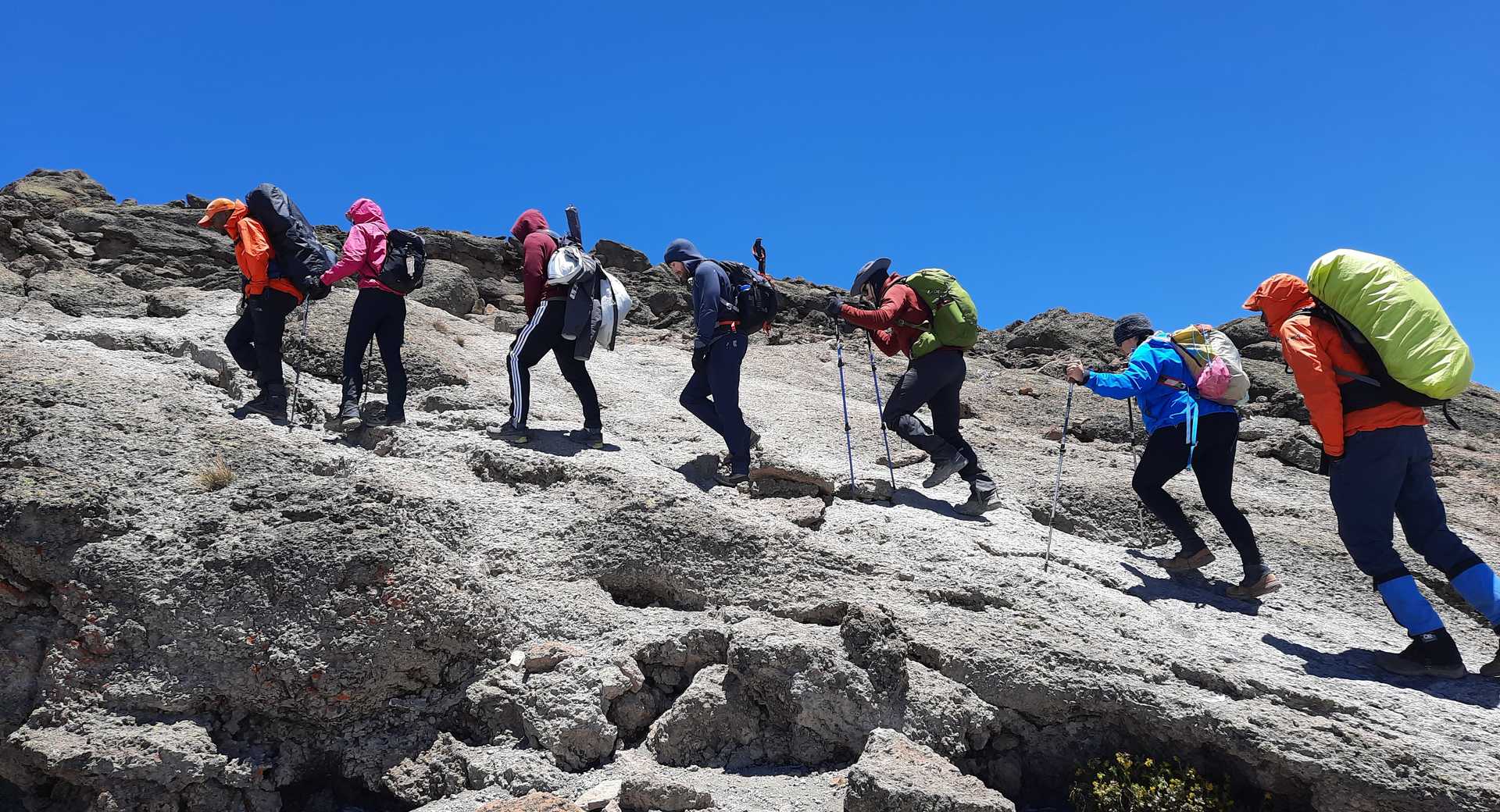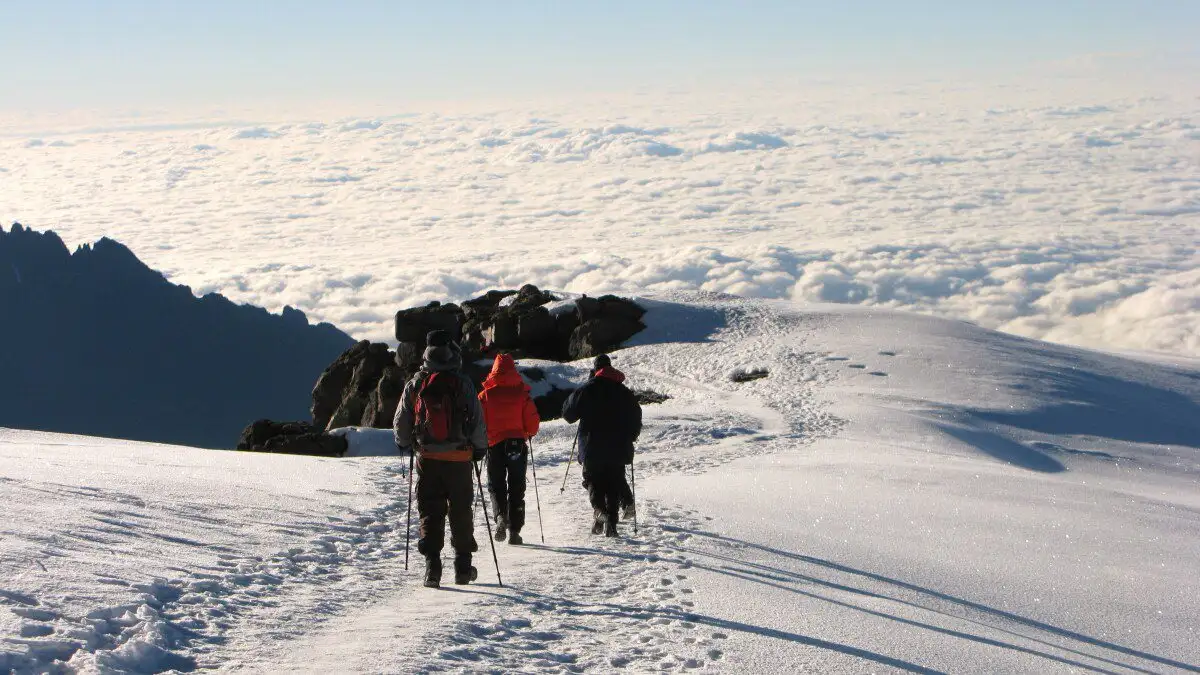Imagine stepping onto the majestic slopes of Mount Kilimanjaro. You’re not just embarking on a thrilling physical journey, but potentially a transformative weight loss voyage too. As you ascend the dizzying heights, your body becomes a calorie-burning powerhouse. But just how much weight can you shed on this trek?
Factors like body type, metabolism, and the intensity of your climb intertwine to determine your weight loss. This adventure is not just about the pounds you shed, but also the strength and endurance you gain. In this post, we will find out how the demanding nature of the climb and the conditions at high altitudes might affect your body’s weight during this formidable journey.

Contents
- 1 Do You Lose Weight Climbing Kilimanjaro?
- 2 How To Lose Weight When Climbing Mount Kilimanjaro?
- 3 Impact of Climbing Kilimanjaro on Caloric Expenditure
- 4 Real Experiences of Individuals Who Lost Weight on Kilimanjaro:
- 5 Frequently Asked Questions
- 5.1 What is the impact of climbing Mount Kilimanjaro on the body?
- 5.2 How does climbing Kilimanjaro affect weight loss?
- 5.3 Can personal fitness impact the Kilimanjaro climb?
- 5.4 Are there shower facilities on Kilimanjaro?
- 5.5 What factors lead to the failure in reaching the Kilimanjaro’s summit?
- 5.6 How many calories does one burn while climbing Kilimanjaro?
Do You Lose Weight Climbing Kilimanjaro?
Climbing Mount Kilimanjaro can potentially lead to weight loss, primarily due to the high physical exertion and calorie expenditure involved in the trek. Climbers burn a significant number of calories each day due to long hours of hiking and the challenging terrain. Additionally, appetite suppression at high altitudes may contribute to lower calorie intake, further increasing the likelihood of weight loss.
However, weight loss is not guaranteed and varies based on individual metabolism, the body’s response to altitude, dietary intake during the climb, and the specific route and pace of the hike. It’s also important to note that any weight loss might include a reduction in muscle mass, not just body fat, due to the strenuous nature of the climb and potential nutritional deficits.
For those considering climbing Kilimanjaro, it’s crucial to prepare adequately, ensuring you have a suitable fitness level and consult healthcare providers about appropriate nutritional strategies both before and during the climb to maintain health and energy levels.
How To Lose Weight When Climbing Mount Kilimanjaro?
Losing weight while climbing Mount Kilimanjaro can be a natural outcome due to the intense physical activity involved. However, if your goal is specifically to lose weight during the climb, here are some focused strategies:

-
Maintain a Caloric Deficit: Consume fewer calories than you burn each day. Given the intense physical activity of climbing, your body will burn a lot of calories. Tailor your food intake to be slightly less than what you need for the day’s energy expenditures.
-
Choose Nutrient-Dense Foods: Opt for foods that are high in nutrients but lower in calories. This includes fruits, vegetables, lean proteins, and whole grains. Avoid high-calorie, low-nutrient foods that might be tempting as quick energy sources.
-
Stay Hydrated: Drink plenty of water. Dehydration can sometimes be mistaken for hunger. Staying hydrated helps with overall metabolism and can prevent overeating.
-
Monitor Portion Sizes: It’s easy to overeat when you’re physically exhausted and your body is craving extra energy. Be conscious of portion sizes and try to eat only until you are satisfied, not full.
-
Manage Snacking: Choose healthy snacks like nuts, dried fruits, and granola that provide energy and nutrients without too much added sugar or unhealthy fats.
-
Keep Moving: While the trek itself is strenuous, maintaining a steady pace without long breaks can help keep your metabolism high throughout the climb.
-
Consult a Professional: Before attempting such a physically demanding task with the goal of weight loss, consult with a healthcare provider or a fitness expert to tailor a plan that is safe and effective for your individual health needs.
Impact of Climbing Kilimanjaro on Caloric Expenditure
Climbing Kilimanjaro has a significant impact on your caloric expenditure due to several factors:

Increased Physical Activity:
- Trekking: Hiking for several hours daily, carrying a backpack, and navigating challenging terrain burns a substantial number of calories.
- Altitude: Your body works harder at high altitudes due to the thinner air, requiring more energy for basic functions. Studies suggest a 6-28% increase in basal metabolic rate at high altitudes.
Dietary Changes:
- Reduced Appetite: High altitude can suppress appetite, leading to lower calorie intake for some climbers.
- Increased Energy Needs: Despite reduced appetite, your body still requires sufficient fuel for the strenuous activity.
Overall:
- Significant Calorie Burn: The combination of increased physical activity and potential changes in appetite can lead to a significant increase in daily calorie expenditure compared to your usual routine.
- Individual Variation: The exact amount of calorie burn depends on various factors like your body weight, fitness level, pack weight, and individual metabolic rate.
Real Experiences of Individuals Who Lost Weight on Kilimanjaro:
Let’s take a look at some real-life experiences of climbers who’ve felt a noticeable reduction in their weight after their Kilimanjaro journey.
- John, the Endurance Runner: John, an avid runner, reported losing around 7 lbs. during his attempt to conquer Kilimanjaro. He attributed his weight loss primarily to the calories burnt during the climb and a decreased food intake because of the strenuous physical conditions.
- Sarah, the first-time Climber: Sarah, embarking on her first high-altitude adventure, experienced a loss of 5 lbs. She pointed out the role of altitude sickness in suppressing her appetite, leading to a lower calorie intake.

- David, the Fitness Enthusiast: David, a frequent gym-goer, noticed his weight dropped by 10lbs post-climb. The continuous exertion and lack of enough caloric compensation were his key factors for weight loss.
Remember, these are actual experiences, but your journey might play out differently. Factors like body type, metabolism, preparation levels, and intensity of climb come into play. Climb Kilimanjaro not just for weight loss, but for the life-altering experience it offers.
Frequently Asked Questions
What is the impact of climbing Mount Kilimanjaro on the body?
Climbing Mount Kilimanjaro can lead to metabolic changes and increase calorie burn due to the physical exertion and altitude. The body requires more carbohydrates and experiences an increased respiratory rate due to the decreased oxygen levels at high altitude.
How does climbing Kilimanjaro affect weight loss?
Climbing Kilimanjaro demands high caloric burn, reducing food intake and potentially leading to weight loss. The degree of weight loss varies among individuals based on factors like the physical exertion and impact of altitude sickness on appetite.
Can personal fitness impact the Kilimanjaro climb?
Yes, personal fitness greatly influences the ability to successfully climb Kilimanjaro. The climb requires the ability to move uphill for several hours daily carrying a loaded backpack. Fitness level can determine how well a person recovers from each day’s demanding vertical hike.
Are there shower facilities on Kilimanjaro?
Since there are no shower facilities on Mount Kilimanjaro, it’s recommended to have a thorough shower before starting the climb. Most climbers opt for a complete wash, including hair, to feel fresh at the beginning of the journey.
What factors lead to the failure in reaching the Kilimanjaro’s summit?
The primary reason some climbers fail to reach the Kilimanjaro’s summit is due to inadequate time spent at high altitude for proper acclimatization. Above 18,000 feet, the body struggles to adjust to the deficient oxygen levels.
How many calories does one burn while climbing Kilimanjaro?
A hiker on Kilimanjaro can burn between 6,000 to 8,000 calories a day compared to an average person burning around 2,500 calories on a regular day. Continuous calorie supply plays a vital role in successfully climbing Kilimanjaro.

Santhan, known to many as Linda, combines her personal training expertise with exceptional motivational coaching skills. Her articles are not just informative but also incredibly inspiring, encouraging readers to take action and pursue their fitness goals. Linda’s unique approach to writing integrates practical fitness guidance with motivational elements, making her content both useful and uplifting.
